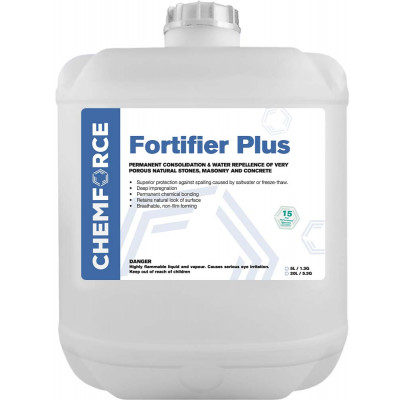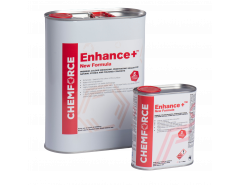Suitable Surfaces
Horizontal and vertical surfaces, including building envelopes (verticals), saltwater pool surrounds, cladding, paving, blockwork, brickwork.
Appropriate for new and restored materials, including: Travertine, sandstone, limestone, precast concrete, cast stone, Saltillo, terracotta, grout, concrete blockwork and very porous bricks.
Additional Benefits
Non film-forming and retains natural colour.
Keeps surfaces looking new for longer, makes cleaning easier.
Fully breathable, allowing water vapor to escape freely, avoiding harmful moisture build-up inside the material.
Designed for indoor and outdoor surfaces on residential and commercial projects.
Negligible change to slip resistance when applied according to our written instructions and guidelines.
High resistance to alkaline (high pH) environments. Concrete is highly alkaline/base and can severely shorten the life of other technologies.
Totally resistant to UV
How to use
ALWAYS TEST PRODUCT ON A SMALL AREA FIRST and allow a 24-hour cure time to determine the ease of application and desired results. Note: Fortifier PlusTM takes 2 to 4 weeks to fully cure inside the pores of the material and reach maximum hardness.
Wear suitable solvent-resistant gloves, protective clothing, safety goggles and an organic vapour respirator during application.
Ensure surfaces to be treated are dry, clean and free of residues.
Surface temperature should be 40 – 950 Fahrenheit / 5 – 350 Celsius.
Product is not to be diluted / thinned.
Mask or otherwise protect surrounding surfaces such as window frames from overspray. If they receive overspray, clean immediately with clean, dry white cotton or other suitable absorbent cloths. Alcohol, methylated spirits or acetone can be used, taking care not to damage paintwork or other coatings.
On very porous materials, apply the product using a low-pressure sprayer with a fan spray nozzle, working from the lowest sections upwards. On dense surfaces, such as marble, apply with a natural bristle brush or lamb’s wool applicator. If you use a brush or applicator made from synthetic material, test to ensure it is not dissolved by Fortifier PlusTM.
Horizontal surfaces: Apply 2 generous coats, at least 10 minutes apart. For the best results, wait longer between coats, but it is important to apply each coat before the previous coat has dried.
Vertical surfaces: To minimize dripping and running it is best to apply 4 lighter coats rather than 2 heavy coats and to begin at the bottom of a surfaces and work upwards.
The material must be allowed to cure for at least 2 weeks before it comes into contact with salt water or solvents.
Total application rate (total of all cots) varies widely depending on the material, porosity and finish: 4 to 12 sq. m. per litre (160 – 480 sq. ft. per gallon).
Thoroughly polish off any excess product residue on the surface with clean, white absorbent cloths before the final coat dries.
Clean equipment with methylated spirits, alcohol or acetone
IMPORTANT – DIP SEALING: Surface materials which are in regular contact with salt water, including the splash zone around salt water pools, must be dip sealed prior to installation to achieve the best result. The material must be fully submerged for a minimum of 15 seconds.
Limitations
WARNING: Fortifier PlusTM will not prevent acid etching or physical wear of the surface. Fortifier PlusTM increase the strength of the surface by up to 40% – this may not be enough to make a very soft, unsuitable stone fit for purpose in a salt water or freeze-thaw environment.
Fortifier PlusTM is breathable, so will not resist static water pressure and should not be used as a waterproof membrane.
Advanced Application Guidelines
Testing and cure time: It can take up to 4 weeks for Fortifier PlusTM to build a structure which is fully cured deep inside the pores of the stone, so it is recommended to let treated surfaces cure for at least 3 weeks before testing.
Applying the right amount of product consistently on a large area:
Only tackle one small area at a time–so that you can apply additional coats before surface residue from the previous coat dries.
Measure out an area before starting application and monitor how much product you use, to get a visual gauge and feel for how much product to spray for each coat.
At regular intervals measure the area you have treated, and the amount of product used, to check that you are consistently applying the desired amount of product.
When applying additional coats, apply each coat perpendicular to the previous coat, to ensure all areas of the surfaces receive a consistent amount of product.
Excess product (product residue):
It is VERY IMPORTANT to thoroughly remove all product residue from a surface with clean, white cotton or microfibre cloths before it dries as the consolidator can be very difficult to remove once cured. If the product has dried on the surface, damp a cloth with Fortifier PlusTM to remove.
The amount of product left on the surface, once the sealer has had time to penetrate, will vary depending on the surface type, porosity and finish. More porous surfaces with a honed (matte) or rougher finish will often absorb all the product applied, leaving no residue, while surfaces such as marble, especially if they have a highly polished finish, will be less absorbent and there will be plenty of excess product to remove. Apply the second coat even if there is product left on the surface from the initial coat.
If the product has dried, damp a cloth with a small amount of product and use this to soften the residue, then polish off with a clean dry cloth.
Cleanup of equipment / spills: Ensure you have a good supply of alcohol, methylated spirits or acetone and clean white absorbent cloths, paper towels to clean your equipment and any overspray.
Applying to vertical surfaces: On vertical surfaces, to minimize dripping and running it is best to apply 4 lighter coats rather than 2 heavy coats and to begin at the bottom of a surfaces and work upwards. Place tarp or plastic sheets below to catch the excess drips. Have plenty of clean white absorbent cloths handy to wipe up runs as they happen.
Quick method for avoiding overspray:
Have a light rectangular piece of board handy which you can hold with one hand to protect surfaces while you spray with the other hand. This is quicker than masking off areas.
Note: If product over spray lands on adjacent surfaces such as window frames, it will cause these to become water repellent, so overspray should be removed with clean white absorbent cloths immediately (methylated spirits, alcohol or acetone can be used but take care not to damage any paint or coating).
Shelf life and storage guidelines
Best within 3 years of manufacture.
Keep container tightly sealed, in a well-ventilated place, at 2 – 300 Celsius (36 – 850 Fahrenheit).
Pack sizes
5L (1.3 gallon), 20L (5.3 gallon)
Yield
3 to 7 sq m. per litre (120 – 280 sq. ft. per Gallon).
Technical data
Active Content: >50%.
SG: ~0.89
VOCs >400g/L
5L (1.3G) = 4.8Kg (10.6Lb), 20L (5.3G) = 19Kg (41.9Lb)
Typical Penetration: 5 – 20mm depending on application rate and surface porosity.
Flammability
HIGHLY FLAMMABLE LEL 3.3% (Ethanol) Flash Point < 23°C UEL 19% (Ethanol)
Hazchem Code ●3YE
Transport
CLASSIFIED AS A DANGEROUS GOOD BY THE CRITERIA OF THE ADG CODE
Shipping name FLAMMABLE LIQUID, N.O.S. (contains ethanol)
UN number 1993
Packing group II
DG Class 3
Subsidiary Risk None allocated
Country of Manufacture:
Australia, by Chemforce Pty Ltd.












Excellent phone manner and fast delivery
Great products and dast delivery.
Very Efficient & Helpful Service and Swift Delivery
The Operations of Diamach are Very Efficient and Swift